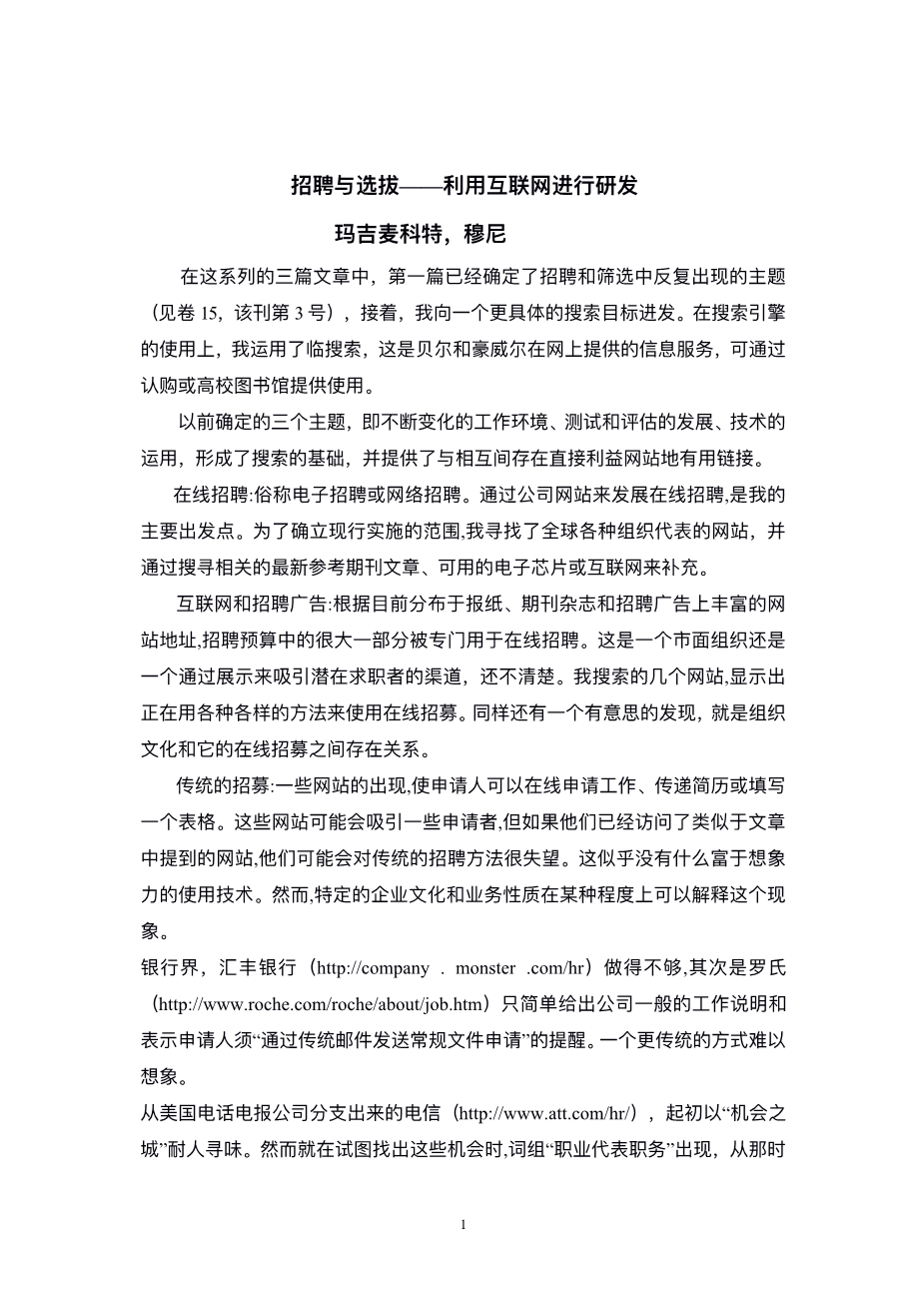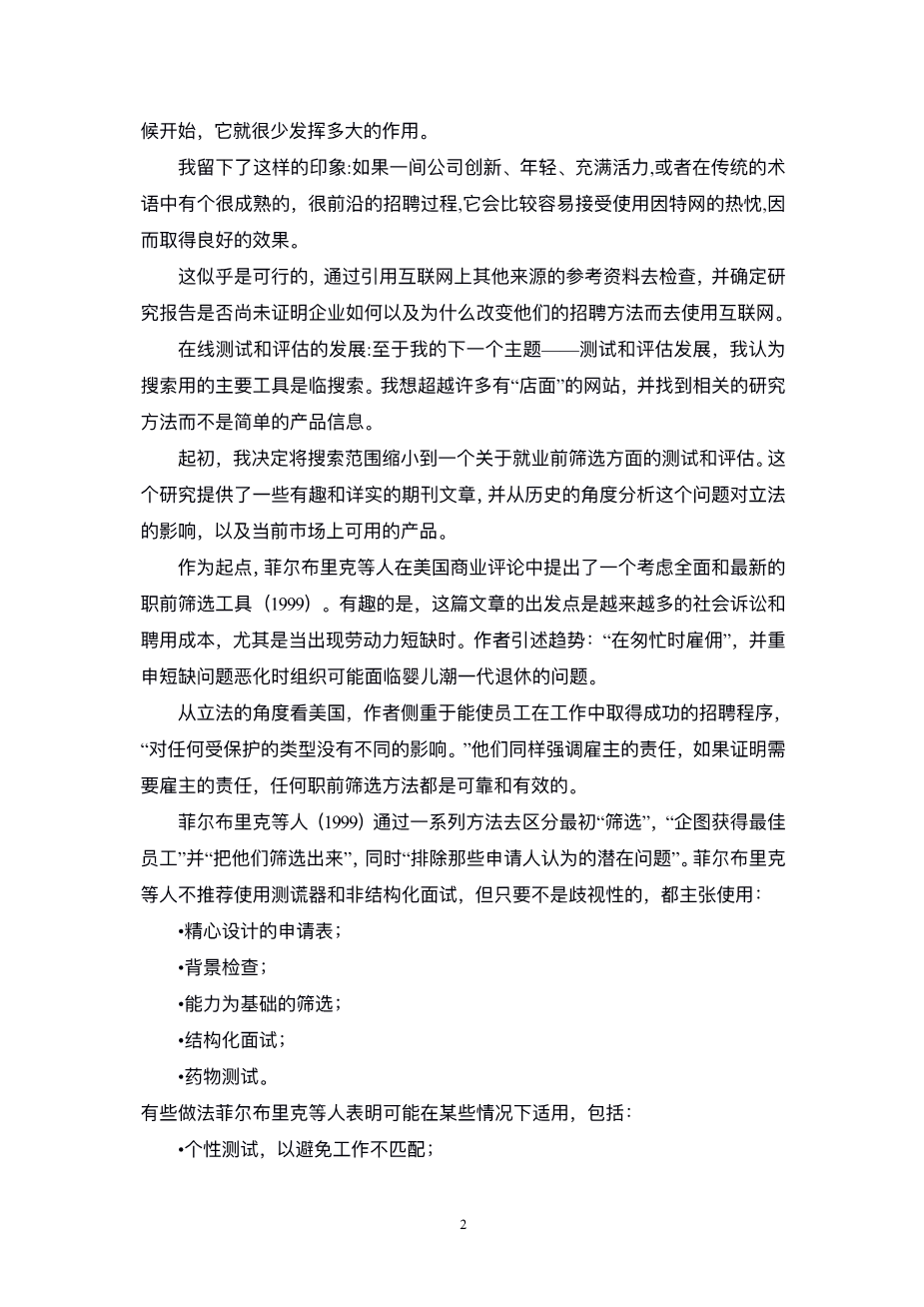Recruitment and Selection Ramp;D using the Internet
Maggie McCourt-Mooney
Having identified in the first of this series of three articles several recurring themes in recruitment and selection (see Vol. 15 No. 3 of this journal) I embarked upon a more specific search. As well as using search engines, I made use of Proquest, an information service provided on the Web by Bell and Howell and available by subscription or through academic libraries.
Three of the themes previously identified - the changing work environment, developments in testing and assessment and the use of technology - formed the basis of the searches and provided useful links amongst a plethora of sites of tangential interest only.
On-line recruiting:Otherwise known as e-recruiting and cyber recruiting. The development of recruitment on-line, and via company Web sites in particular, was my starting point. In order to establish the range of current practices, I searched a variety of Web sites representative of global organizations. This was supplemented by a search for relevant and up-to-date references in journal articles or available and/or accessible through the Internet.
The Internet and recruitment advertising:Judging by the wealth of Web site addresses now found in newspapers, journals and in job advertisements, some substantial part of the recruitment budget is being devoted specifically to on-line recruitment. Whether this is to market the organization or to be a showcase to attract potential job seekers is not clear. My search of several Web sites revealed a wide variety of approaches to the use of on-line recruiting. An equally interesting observation was the relationship between the culture of an organization and its on-line recruitment practices.
Traditional recruitment practices:Several sites, however, appeared either to merely state that applicants could apply for jobs on-line and/or should send reacute;sumeacute;s or complete a form. These sites may attract some applicants, but if they have already visited sites like those reviewed earlier in this article, they may well be discouraged by the very traditional approach. There appears to be little imaginative use of the technology. However, the particular companys culture and/or the nature of its business may go some way to explaining this.
HSBC in the banking sector at http://company.monster.co.uk/hsbcuk/ was notably uninteresting, closely followed by Roche at http://www.roche.com/roche/about/job.htm which simply gave general descriptions of jobs in the Company and stated that applicants should 'send application with usual documents via conventional mail'. A more traditional approach is hard to imagine.
ATamp;T from the telecommunications sector at http://www.att.com/hr/ was at first intriguing with its 'City of opportunities'. However on trying to find out what these opportunities were, the phrase 'Occupational represented positions' appeared and from then onwards very little made much sense.
I was left with the impression that if a company was innovative or young and dynamic, or had a very mature and leading edge recruitment process in traditional terms, it would be likely to embrace the use of the Internet warmly and to good effect. It seemed valid to check this out with other sources of reference on the Internet and to establish whether research reports are as yet demonstrating how and why companies are changing their recruitment practices to use the Internet.
Developments in testing and assessment:Turning now to my next theme of developments in testing and assessment, the primary tool I used for this particular search was Proquest. I wanted to go beyond the 'shop front' approach of many Web sites and find relevant research rather than simply product information.
Initially, I decided to narrow my search to one aspect of testing and assessment pre-employment screening. This search provided several interesting and informative journal articles on the subject ranging from an historical perspective to guidance on legislative implications and current products available in the market place.
As a starting point, a very thorough and up-to-date consideration of pre-employment screening was found in American Business Review by Philbrick et al. (1999).
Interestingly the starting point of this article was the increasingly litigious society and the cost of hiring particularly when there are labor shortages. The authors quote the tendency to 'hire in a hurry' and reiterate the problem of worsening shortages that organizations are likely to face when Baby-Boomers retire.
From a US legislative standpoint the authors place emphasis on ensuring that any recruitment procedures are related to employee success on the job and 'do not have a disparate impact on any protected class' They equally emphasis the onus on the employer to demonstrate if required that any pre-employment screening method is reliable and valid.
Philbrick et al. (1999) review a range of approaches to screening making the initial distinction between 'screening in', which is 'an attempt to get the best employees' and 'screening out', or 'an attempt to exclude those applicants believed to have potential problems'. Philbrick et al. do not recommend use of the polygraph and unstructured interviews but provided they are in no way discriminatory, the authors do advocate the use of:
bull;carefully designed application forms;
bull;background checks;
bull;competency based screening;
bull;structured interviews; and
bull;drug testing.
Some practices which Philbrick et al. suggest may have some use in certain circumstances include:
bull;personality testing to help avoid job mismatching;
bull;integrity testing; and
bull;hand-writing analysis - with the following proviso.
The other significant issue raised by Philbrick et
剩余内容已隐藏,支付完成后下载完整资料


英语译文共 5 页,剩余内容已隐藏,支付完成后下载完整资料
资料编号:[245652],资料为PDF文档或Word文档,PDF文档可免费转换为Word
您可能感兴趣的文章
- 薪酬满意度作为工作满意度的先行因素:建立一个回归模型,确定公共和私人组织中薪酬满意度与工作满意度之间的线性关系外文翻译资料
- 胜任力与胜任力、胜任力模型与胜任力模型的比较研究外文翻译资料
- 如何提高企业网络招聘的有效性外文翻译资料
- 为初级职位招聘大学生,在制定战略和战术校园招聘计划时,需要考虑哪些问题?外文翻译资料
- 基于能力的招聘:招聘和留住成功员工的关键外文翻译资料
- 员工培训对体育门票销售人员工作满意度的影响外文翻译资料
- 由雇主参与的创新型员工激励模式外文翻译资料
- 浅析企业文化与企业绩效的相关性 ——以苏州金色未来信息咨询股份有限公司为例外文翻译资料
- 互联网背景下基于平衡计分卡的计算机绩效评价系统外文翻译资料
- 提高斯洛伐克公共行政部门招聘过程的效率外文翻译资料


